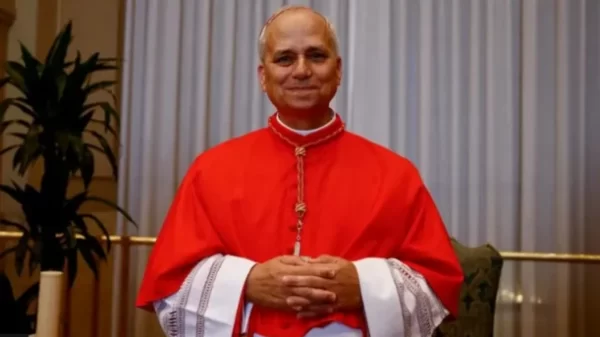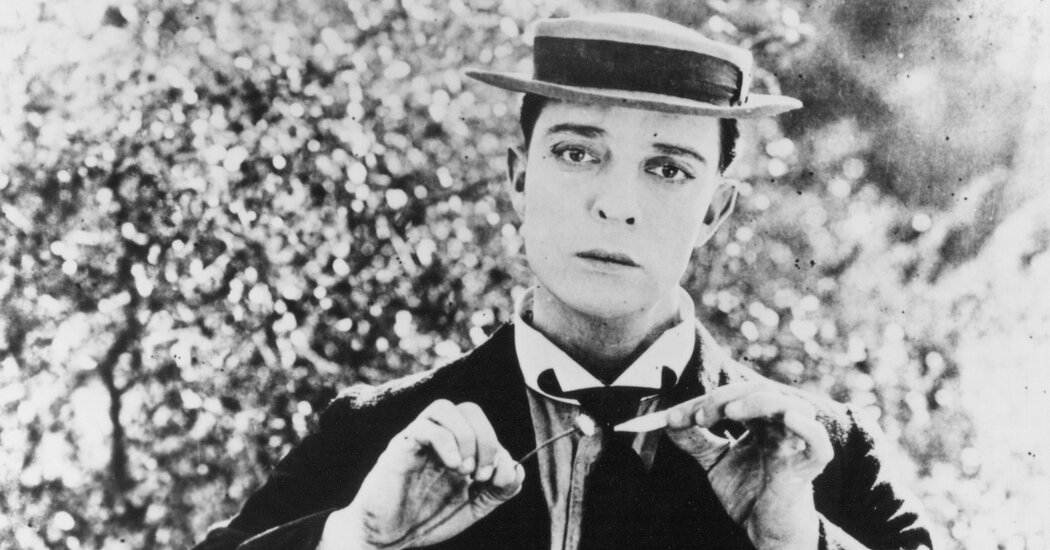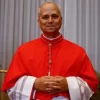BUSTER KEATON
A Filmmaker’s Life
By James Curtis
CAMERA MAN
Buster Keaton, the Dawn of Cinema, and the Invention of the Twentieth Century
By Dana Stevens
Is there pent-up demand for books that span the life of a deadpan dead man? This season marks the publication of not one but two major biographies of Buster Keaton, the silent-screen comedy titan who distinguished himself from his foremost peers, Charlie Chaplin and Harold Lloyd, with his squished porkpie hat and stone face.
That stoic mug stares out intimidatingly from the cover of James Curtis’s comprehensive survey “Buster Keaton: A Filmmaker’s Life.” It was so instantly recognizable in Keaton’s 1920s heyday that Metro Pictures, one of the studios that financed the star’s films, marketed him variously as the “sad-faced comedian,” the “frozen-faced comedian” and — now here’s an irresistible tag! — the “boy with the funeral expression.”
Keaton came by this expression naturally, recognizing its comic potential as a child player in vaudeville. He was born into show business on Oct. 4, 1895, the son of Joe and Myra Keaton, an itinerant performing duo who billed themselves as “the Eccentric Tad and the Chic Soubrette.” Curtis, who has also written mighty biographies of Preston Sturges, James Whale, W. C. Fields and Spencer Tracy, does a delightful job of capturing the old, weird America in which the Keatons plied their trade, Joe with his acrobatic pratfalls and high kicks, and the 4-foot-11 Myra with her musical accompaniment on piano and saxophone.
At the time of Buster’s birth, the Keatons were part of a traveling troupe affiliated with the Umatilla Indian Medicine Company, which hustled tonics and ersatz folk remedies to a gullible public. Admission to these medicine shows was free, but most attendees ended up splurging on dubious unguents and cough syrups. It was the troupe’s compère and chief salesman, a London-born comedian named George A. Pardey, who assigned young Joseph Frank Keaton the name he would carry the rest of his life. Observing the toddler bouncing fearlessly down a flight of stairs, Pardey proclaimed: “Gee whiz! He’s a regular buster!”
Buster’s capacity for getting knocked around without complaint proved critical to his family’s fortunes. By the time he was 5, Keaton and his father had perfected a violent, Itchy & Scratchy-like routine in which, bizarrely, they dressed as pantomime Irishmen with matching high foreheads, auburn whiskers and tartan get-ups. (In the business, the senior Keaton’s act was categorized as a “rough Irish specialty.”) The irreverent boy disrupted his father’s stunts, prompting a mock-enraged Joe to hurl Buster great distances. Cue roaring audience laughter. Before long, the act was renamed the Three Keatons and was a major draw on the vaudeville circuit.
As agile an acrobat as his father, Buster was proficient at avoiding injury even as he was flung hither and yon. His propensity for showing as little emotion as possible during his calamitous encounters with Dad made the act even funnier. “It’s just my way of working, I guess,” Keaton said in an interview quoted in Curtis’s book. “I have found — especially on the stage — that when I finish a stunt, I can get a laugh just by standing still and looking at the audience as if I was surprised and slightly hurt to think that they would laugh at me.”
This combination of talents proved felicitous when Keaton inevitably aged out of the family act and started making movies. His greatest works from his golden decade, the 1920s, combine physical derring-do, visual gags stacked one atop another and that face. In his short “One Week,” Keaton and his love interest, played by Sybil Seely, attempt to build a mail-order-kit house, only for their dreams to be foiled by mismatched parts and their own incompetence. The movie’s bravura sequence finds the couple hosting a dinner party during a storm that sets their home spinning on its foundation, with Buster tossing centrifugally in and out of the house like a lettuce leaf in a salad spinner. In his 1924 full-length feature “Sherlock Jr.,” Keaton speeds through various locales while crouched upon the handlebars of a motorcycle that has lost its driver, surviving a gantlet that includes heavy city traffic, an oncoming train and the traversal of a broken bridge whose gap is filled, just in the nick of time, by two trucks moving in opposite directions.
Keaton was as much a technical innovator as he was a comic, and Curtis’s book goes into painstaking detail about how these effects were achieved. (The spinning house was built on a turntable whose control belt was buried in dirt and grass.) Every bit as important, “Buster Keaton” serves as a welcome corrective to the perception that Keaton’s was a tragic life undone by drink and the advent of the talkies. This myth is partly a function of Keaton’s persuasiveness as an actor in his later years: grimly staring down his losing hand as one of the washed-up old-Hollywood “waxworks” who play cards with Norma Desmond in Billy Wilder’s “Sunset Boulevard” (1950) and impassively dancing the twist with the bikini-clad starlet Bobbi Shaw in the teensploitation flick “Beach Blanket Bingo” (1965, a year before his death).
Curtis does not shy away from Keaton’s rock-bottom 1930s, when he lost his creative autonomy at MGM, wriggled out of a loveless marriage to his first wife, Natalie Talmadge, and drank so heavily that he was, for a time, unemployable. But the overall picture he paints is of an even-keeled showbiz lifer who was simply happy to keep on working. Unlike many of his contemporaries, Keaton never looked down on television, warming early to its potential to reach millions. He hosted a variety program on a local station in Los Angeles and starred in clever ads for Alka-Seltzer; Curtis notes that Keaton thought of TV commercials “as little comedy shorts akin to the two-reelers” that he made in his youth. One Easter Sunday in the 1960s, he stopped by a party hosted by Mary Pickford and pitied the silent-movie stars in attendance. “I discovered we had nothing to talk about,” Keaton said. “Some of them had never heard a Beatles record. They hadn’t kept up with the times.”
Five Movies to Watch This Winter
1. “The Power of the Dog”: Benedict Cumberbatch is earning high praise for his performance in Jane Campion’s new psychodrama. Here’s what it took for the actor to become a seething alpha-male cowboy.
Keaton’s final act was a contented victory lap in which he lived modestly in the San Fernando Valley town of Woodland Hills, happily married to his third wife, Eleanor Norris, and cognizant of the renewed esteem in which his silent films were held. The lack of operatic highs and lows in Keaton’s life can make Curtis’s straight-ahead, sequentially narrated bio a slog if you’re not a committed Buster Boi, but it’s as definitive an account of the sad-faced comedian as one could hope for.
Dana Stevens’s “Camera Man: Buster Keaton, the Dawn of Cinema, and the Invention of the Twentieth Century” is a welcome complement, in that Stevens, a movie critic for Slate, contextualizes Keaton’s achievements in a way that Curtis does not. In an elegant preface, Stevens positions 1895, the year of Keaton’s birth, as a crucially transitional time, “not yet the 20th century but the still-illegible sign of what it might become.” Marconi has only just succeeded at “transmitting radio waves over a considerable distance.” Freud is struck by the idea to analyze his patients by interpreting their dreams. And in the basement of a Paris cafe, the Lumière brothers screen their moving pictures for a paying audience for the first time.
Buster emerges in the new century as an agent of what we would now call disruption. He, Chaplin and Keaton’s filmmaking mentor, Roscoe “Fatty” Arbuckle, aren’t just funnymen but entrepreneurs, early adopters of new technology whose smarts and foresight earn them tons of money and admiration. Like the tech bros of today, they meet a mixed bag of fates. Chaplin is the most revered but spends his later life in a gilded prison of his own self-importance and melancholy. Arbuckle is brought low by a scandal in which he is charged with killing a young actress and later exonerated, but not before his career is left in ruins. (Stevens, a fierce Arbuckle defender, portrays Keaton as a loyal friend who gives the post-scandal Roscoe work as a gag writer and uncredited co-director.) Keaton is the least business-minded — terrible at deal making, hence his never-ending gigging — but the most purely creative, a workaholic whose passion is thinking up gags.
Stevens clearly adores her subject, describing him as a “solemn, beautiful, perpetually airborne man.” “Camera Man” is less a traditional biography than a series of reported essays about the progress of the 20th century with Keaton at their center. Sometimes Stevens ventures too far afield, as when she devotes the better part of a chapter to an unnecessary examination of the Hollywood struggles of F. Scott Fitzgerald — a man with whom Keaton was apparently unacquainted — on the grounds that both men were alcoholics with marital troubles who were unhappily employed at MGM at the same time.
But Stevens is sharper when she focuses on such ancillary phenomena as the emergence of serious film criticism, an entirely new writerly discipline. She flags the precise moment, in a review of Keaton’s 1923 feature “Three Ages,” when Life magazine’s Robert Sherwood “pushes film criticism in a new direction as he brings events outside the theater to bear on his experience inside it” by praising Keaton’s ability “to keep this much-molested human race in good humor, at a time when it has nothing but high taxes, United States senators, coal strikes, banana shortages, wrong numbers and Signor Mussolini to think about.”
Nearly a hundred years later, as we face a nearly identical list of vexations, give or take a surname, Keaton’s lovingly created shorts and features still have this beneficial effect. Curtis and Stevens have done well to bring the boy with the funeral expression back from the dead.




























